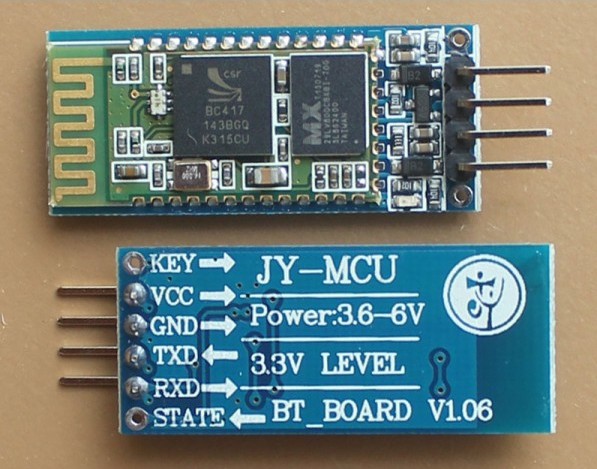
With the final project approaching, I am slowly aiming to build the knowledge and skills requires to implement motor control, bluetooth functionality, and simple control of these two functions through an iOS interface (packaged within an app). With reference to networking in particular, the main agenda was to make bluetooth function and successfully be located as a bluetooth device, preferably on an iOS device.
In preparation, I ordered an HC 05 board off of eBay for bluetooth connectivity. Based on researching a number of projects using bluetooth throughout the web, there seemed to be plentiful resources for the HC 05. Upon bringing the part into SC102, I came to realize that this part was quite inexpensive because it was in fact only the base board, without the actual chip. While alarmed and frustrated, we did indeed have a ready to use HC 05 board available in the lab after all.
To begin, I researched both the device itself and others from the course who have looked into serial communication. The HC 05 bluetooth device uses serial communication to send and receive data. This means that data is sent one bit at a time over a designated channel of communication. This is thus unlike parallel communication, which sends bits as a whole through parallel channels. There are numerous resources available to look into this further. The specific HC 05 is a serial transceiver module, intended for wireless connections. It uses 3.3V signals, but can operate at 5V or up to 6V. We will be using this device to send and receive data to another bluetooth-enabled device.
At first, I was hoping to use the board that was fabricated last week to control my DC motor, but realized that this board was actually missing some of the necessary components. I made it all the way to trying to program the board before realizing this. Afterward, I transitioned to using an Arduino Uno, with a breadboard, as a bespoke board will be made later for the final project and because this was simply intended for a proof of concept. In order to regulate the voltage, I used a 20k ohm and 10k ohm resistor in order to avoid damaging either the bluetooth module or the Arduino board. With help from a few pages from Fab Academy, I was able to program the device via the Arduino IDC and identify it on another device.
There are some followup notes for the final project. First off, while I had planned to use the HC 05 module for an iOS app, I learned that the module is not compatible, but is compatible for android devices. The reason for this is because HC 05 is based on Bluetooth 2.0, whereas iOS devices require Bluetooth 4.0 or BLE, bluetooth low energy.
After discussing this topic with Rob, we concluded that it may be best to move forward with a BLE module for the final project, as the module will be far less energy intensive and also functional with IOS. I will likely plan to use an ESP-WROOM-32 BLE module, as these are available in SC102. While the module is somewhat substantial in size, I could otherwise use an RN4871 bluetooth microchip, which has a considerably smaller footprint.





